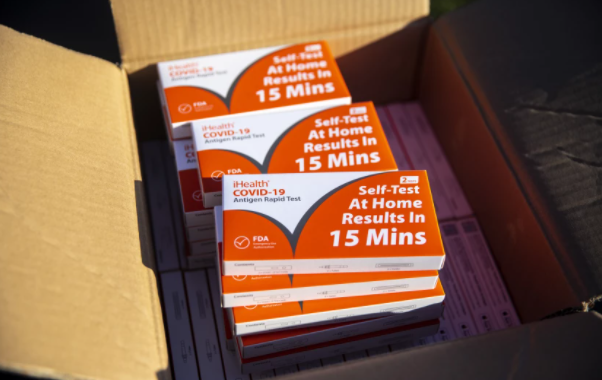
At-home coronavirus screening has become a way of life for many Californians, but some medical experts are now cautioning that one test may not be enough to determine whether someone is infected.
Health officials stress that at-home tests are a vital and accurate way of tracking COVID-19 infections but an initial negative test doesn’t mean people are out of the woods. The U.S. Food and Drug Administration suggested last week that those checking to determine whether they are infected should use multiple tests over a period of days. “When you perform an at-home COVID-19 antigen test(抗原检测) and you get a positive result, the results are typically accurate,” government officials wrote in a public statement. “However, if you perform an at-home COVID-19 antigen test, you could get a false negative result.”
Because of this, the agency “recommends repeat testing following a negative result, whether or not you have COVID-19 symptoms.” “If your first home antigen test is negative, we recommend repeating it in 24 to 48 hours,” Dr. Ralph Gonzales, a UC San Francisco associate dean, said during a recent campus town hall. Gonzales said he has noticed an additional time lag(时间差) in how long it takes a rapid test to turn positive following the beginning of symptoms—especially early on. Some people aren’t testing positive using rapid tests until four or five days after they start to show symptoms, according to UC San Francisco infectious diseases expert Dr. Peter Chin-Hong. “That’s very common these days,” he said.
At-home COVID-19 rapid tests are expected to detect a coronavirus infection at least 80% of the time, according to the FDA. By contrast, a lab-based PCR test is generally expected to detect the virus 95% of the time someone is infected. But PCR tests can take a day or longer to process, while rapid test results are available within 15 minutes. If you have COVID-19 symptoms and get a negative rapid test result, the FDA suggests testing again 48 hours later. If the second test is negative and you’re still concerned your symptoms are caused by COVID-19, the FDA suggests either a third rapid test or a lab-based PCR test.
本时文内容由奇速英语国际教育研究院原创编写,未经书面授权,禁止复制和任何商业用途,版权所有,侵权必究!(作者投稿及时文阅读定制请联系微信:18980471698)
1.What does the underlined phrase “out of the woods” in Paragraph 2 probably mean?
A Waiting for the results of tests.
B Not attacked by COVID-19.
C Having COVID-19 symptoms.
D Infected with COVID-19.
解析:选B。B词义猜测题。根据第二段最后一句可知,在家中进行新冠病毒的检测,可能会出现假阴性结果。即在家自测新冠病毒感染快筛,首次阴性结果可能会是假的,即首次自测阴性结果并不意味着被检测人未感染新冠病毒。故选B。
2.What does Gonzales advise to do if you have a negative home antigen test result?
A To have rapid tests every day.
B To stay at home for 24 to 48 hours.
C To ignore it if there are no symptoms.
D To have a second test in one to two days.
解析:选D。D细节理解题。根据第三段第二句的“If your first home antigen test is negative, we recommend repeating it in 24 to 48 hours,”可知,如果你第一次在家自测结果是阴性,一到两天内需再次检测。故选D。
3.What advantage does a rapid test have compared with a PCR test?
A It shows more symptoms.
B It costs less money.
C It is more accurate.
D It takes less time.
解析:选D。D推理判断题。根据最后一段第三句“But PCR tests can take a day or longer to process, while rapid test results are available within 15 minutes.”可知,PCR测试结果需要等待一天甚至更久,而快速检测只需15分钟就能出结果。因此快速检测用时更短。故选D。
4.What can be a suitable title for the text?
A Different methods of testing COVID-19
B The advantages and disadvantages of rapid tests
C Rapid tests are better than PCR tests
D Rapid tests may require more than one test
解析:选D。D主旨大意题。全文主要讲的是对于新冠,一次快速检测的阴性结果可能并不准确,需要再次检测以确保安全。故选D。